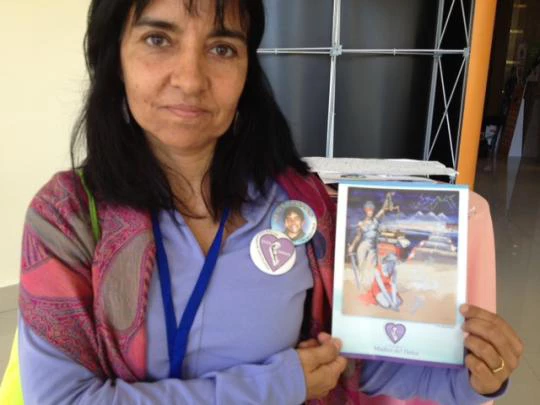 The name of the woman in the picture is Viviam Perrone. Her fourteen-year-old son Kevin was killed by a drunk driver via a hit-and-run in Argentina, her home country. If that were not enough, her husband died of a stress-induced heart attack in the days leading up to the trial of the driver (who had been tracked down), leaving her alone to raise her two other children. The driver ended up serving less than two months in jail.
The name of the woman in the picture is Viviam Perrone. Her fourteen-year-old son Kevin was killed by a drunk driver via a hit-and-run in Argentina, her home country. If that were not enough, her husband died of a stress-induced heart attack in the days leading up to the trial of the driver (who had been tracked down), leaving her alone to raise her two other children. The driver ended up serving less than two months in jail.
After picking up the pieces of her shattered life, Viviam chose to act and has helped build Madres del Dolor (“Mothers of Pain”), an NGO that focuses on advocating for victims’ rights in the courts system, for those who have suffered violence through road crashes, gun violence or sexual assault. As she describes it, her work is cathartic as she seeks to redress the conditions in the transport system that led to the death of her child.
I met Viviam on April 4 at the third Meeting of the Global Alliance of NGOs for Road Safety . This Alliance seeks to play a coordinating role for NGOs working to improve road safety at the country level through advocacy, legislation or behavioral interventions. It is supported by the Global Road Safety Facility, for which I work, the World Health Organization, and other partners under the auspices of the UN Decade of Action for Road Safety .
Around 1.3 million persons are killed annually through road crashes, and approximately 90% of these crashes occur in low- or middle-income countries (LMICs), costing them 1-3% of GDP on average. This epidemic is a larger global burden of disease than malaria or tuberculosis. Indeed, the Global Burden of Disease Study, launched recently by Bill Gates, shows non-communicable diseases clearly on the rise. Road crashes specifically are the only “injury-induced” cause of global death in the top 10, and they are the number one cause of death for ages 15-24 and number two for ages 25-39.
Adding to this toll, our planet is facing an unprecedented growth in motorization. It took the human race about 100 years of motoring history to reach 1 billion vehicles: in the next two decades, the number is expected to double to 2 billion, with growth rates of more than 7-8% per annum in China and India alone. This comes with a dangerous mix of people and vehicles on the roads, with vulnerable road users (pedestrians, motorcyclists, cyclists, etc.) accounting for the majority of deaths in LMIC road crashes. Individuals involved in road crashes and their families in LMICs risk falling back into--or being stuck--in poverty due to overwhelming medical costs, poor rehabilitative services and lack of safety nets.
Mitigation is possible, though, and that is where the World Bank, the NGO Alliance, and other development partners come in. We have developed plans and tools to help countries improve their road safety outcomes. We have the Safe System approach which countries such as Argentina are implementing, with support from the World Bank . A pillar of this approach is collaboration between the Transport and Health sectors to develop effective public management frameworks to help countries tackle the growing burden road crashes impose.
After all, if we knew an infectious disease was about to ravage generations of youth, would we not do all we could to prevent it if the vaccine was known? The question is rhetorical. Yet, the photo of Kevin on the badge Viviam wears reminds me of the answer.


Join the Conversation